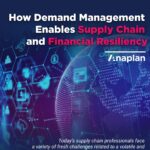
Integrated and Predictive – The Future of Corporate Planning
Integrated Planning Provides a Solid Foundation in a Dynamic Environment
Our world has become more fast-moving and dynamic than ever. This generates significant challenges for organizations in many areas and corporate planning and forecasting are no exceptions. In particular, the integration of strategic planning and company-wide operational planning, as well as its integration with analytics and business intelligence (BI), are becoming increasingly important to making comprehensive and well-founded decisions based on data.
In addition, the use of predictive technologies and algorithms for corporate planning is gaining in significance in many organizations. The aim is to relieve planners and use historical data for valuable forecasts of the future.
The solid integration of corporate planning and its integration with analytics is the basis of modern, data-driven corporate management. It not only increases the speed and transparency of decisions and their quality, but it is also the foundation for the use of predictive planning and forecasting powered by statistical methods and machine learning.
The study is based on a worldwide online survey of 424 companies.
Faster information, digital change and data quality are the greatest challenges
The fast pace and dynamics of the market and competition make the ever faster provision of information for decision support the greatest challenge for companies at the moment. Organizations face increasingly dynamic environments with more frequent and comprehensive forecasts, simulations and analyses. The volatility of environments and growing time pressure are forcing companies to update their targets and forecasts at ever shorter intervals. Planning, forecasting and analytics must be adapted to keep up with these demands.
Integrated planning and analytics is the essential foundation for decision-making
While companies continue to attach great importance to planning, these increasing pressures are mercilessly exposing the current challenges. Many companies have a lot of catching up to do when it comes to the robust integration of enterprise planning. The connection between the long-term, strategic view and the short-term view is often lacking, as is the integration of the non-financial, operational view with the financial view.
Companies are striving to achieve holistic integration to gain a competitive edge
In dynamic times, organizations are updating their targets and forecasts at shorter notice to speed up the provision of information for decision-making. More frequent and comprehensive forecasts, simulations and analyses require sustained investment in planning and forecasting. Integrating planning with analytics and automating processes with technology are top priorities for companies.
Automation is accompanied by the use of – and investment in – modern technology and includes potential use cases such as automatic data collection from different data sources, workflows to control processes and process participants and early warning mechanisms based on thresholds. The resulting increase in speed and insightfulness as well as the reduction of manual effort involved in corporate planning are a positive side effect.
Predictive algorithms will fundamentally change the way companies plan
In order to reduce the effort required for planning and to accelerate it in an increasingly dynamic environment, many organizations see modern planning approaches such as predictive planning and forecasting as a helpful aid. Nine out of ten organizations rate the approach as very important or important. Predictive models are designed to improve the results of planning as well as the planning processes themselves to achieve meaningful results more quickly.
A strong contradiction to the assessment of the relevance and potential of the approach is the still low level of use in practice. Two thirds of companies are only just beginning to deal with predictive planning and forecasting or have hardly gained any experience yet. Furthermore, the comprehensibility of automated forecasts and a realistic assessment of their potential are key factors in their acceptance and further dissemination.
Transparency of results is essential for predictive planning and forecasting
More than 90 percent of the organizations surveyed are convinced that the integration of corporate planning with analytics creates high added value and is essential for corporate management. This is one of the reasons why many organizations want to invest in improving integration. As the backbone of modern planning approaches such as predictive planning and forecasting, companies are tapping completely new potential to increase the efficiency of their processes. Predictive planning and forecasting in particular have great potential to fundamentally change future corporate planning under the right conditions.
Source: bi-survey blog



